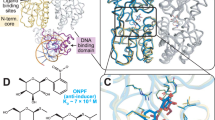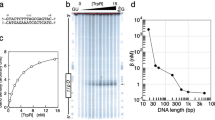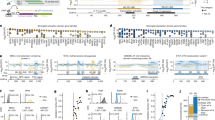Abstract
In the crystal structure of a represser–operator complex (the 434 repressor DNA-binding domain and its 14-base pair (bp) operator), Anderson et al.1 elsewhere in this issue identify six positions of likely contact between repressor protein and phosphates of the DNA backbone. At each of these positions, electron densities of protein and DNA merge. Experiments presented here indicate that intact 434 repressor approaches these phosphates very closely when it is bound to DNA in solution. Specifically, when any one of these phosphates is ethylated2, repressor cannot bind to the modified operator. We also identify another position where ethylation has a significant but less dramatic effect on repressor binding, and note that in the structure, repressor closely approaches this phosphate. Our results strongly support the idea that the interactions between protein and the DNA phosphate backbone in the crystallized complex1 are the same as those made by intact repressor to operator DNA in solution. In addition, our results suggest that DNA is slightly bent by repressor binding.
This is a preview of subscription content, access via your institution
Access options
Subscribe to this journal
Receive 51 print issues and online access
$199.00 per year
only $3.90 per issue
Buy this article
- Purchase on Springer Link
- Instant access to full article PDF
Prices may be subject to local taxes which are calculated during checkout
Similar content being viewed by others
References
Anderson, J. E., Ptashne, M. & Harrison, S. C. Nature 316, 596–601 (1985).
Siebenlist, U. & Gilbert, W. Proc. natn. Acad. Sci. U.S.A. 77, 122–126 (1980).
Hendrickson, W. & Schleif, R. Proc. natn. Acad. Sci. U.S.A. 82, 3129–3133 (1985).
Fried, M. & Crothers, D. M. Nucleic Acids Res. 9, 6505–6525 (1981).
Garner, M. M. & Revzin, A. Nucleic Acids Res. 9, 3047–3060 (1981).
Hol, W. G. J., van Duijnen, P. T. & Berendsen, H. J. C. Nature 273, 443–446 (1978).
Maniatis, T., Fritsch, E. F. & Sambrook, J. Molecular Cloning, A Laboratory Manual (Cold Spring Harbor Laboratory, New York, 1982).
Dente, L., Cesareni, G. & Cortese, R. Nucleic Acids Res. 11, 1645–1655 (1983).
Messing, J. Meth. Enzym. 101, 20–79 (1983).
Miller, J. H. Experiments in Molecular Genetics (Cold Spring Harbor Laboratory, New York, (1972).
Maxam, A. M. & Gilbert, W. Proc. natn. Acad. Sci. U.S.A. 74, 560–564 (1977).
Anderson, J., Ptashne, M. & Harrison, S. C. Proc. natn. Acad. Sci. U.S.A. 81, 1307–1311 (1984).
Pabo, C. O. & Lewis, M. Nature 298, 443–447 (1982).
Author information
Authors and Affiliations
Rights and permissions
About this article
Cite this article
Bushman, F., Anderson, J., Harrison, S. et al. Ethylation interference and X-ray crystallography identify similar interactions between 434 repressor and operator. Nature 316, 651–653 (1985). https://doi.org/10.1038/316651a0
Received:
Accepted:
Published:
Issue Date:
DOI: https://doi.org/10.1038/316651a0
This article is cited by
-
Methods for the analysis of DNA-protein interactions
Molecular Biotechnology (1997)
-
Structure of a phage 434 Cro/DNA complex
Nature (1988)
-
Structure of the represser–operator complex of bacteriophage 434
Nature (1987)
-
A phage repressor–operator complex at 7 Å resolution
Nature (1985)
Comments
By submitting a comment you agree to abide by our Terms and Community Guidelines. If you find something abusive or that does not comply with our terms or guidelines please flag it as inappropriate.



